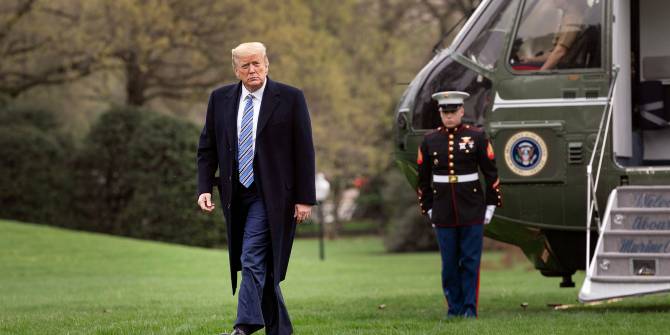The UK may end up with a no-deal, ‘WTO Brexit’. WTO members want more flexibility in rule-making. But this has hitherto been impossible to achieve across the board, so members have pursued smaller-scale agreements that ultimately undermine the WTO’s cohesion. Jacqueline Maldonado Ortega and Ira Poensgen (LSE) propose a different approach.
The signing of the Marrakesh Agreement in 1994 is often regarded as the dawn of a new era for the multilateral trading system. It founded the World Trade Organisation (WTO), creating an international body tasked with providing a forum for trade negotiations, allowing member states to strengthen their commitments and develop new rules, and equipped with the necessary tools to resolve international trade conflicts.

To date, however, there has only been one attempt at a comprehensive round of negotiations – the Doha Development Agenda (DDA) – which has famously failed to deliver. This means that the last major update of the multilateral trade rules happened over 25 years ago. Since then, the underlying realities of trade have dramatically shifted, with a rise in trade in services, the birth of globally distributed value chains and the creation of entirely new sectors such as e-commerce. So it is not surprising that many regard the multilateral rules as outdated.
While scholars have put forward competing diagnoses for the WTO’s inability to foster new agreements, most acknowledge that the rigidities of the WTO rule-making system contributed to the gridlock. The Uruguay Round was the first multilateral round to be negotiated as a “single undertaking”, and the DDA was supposed to be equally comprehensive. Coupled with a tradition of consensus-based decision making, these negotiations turned out to be prohibitively difficult. Critics argue that a meaningful update of the multilateral trading system is no longer possible under these circumstances. Therefore, the debate turned towards the need to create flexibilities in rule-making.
This discussion centres around the use of plurilaterals – issue-specific agreements among subgroups of WTO member states. In recent years a range of joint statement initiatives have been launched, in which groups of WTO members negotiate rules in areas such as e-commerce and investment facilitation. Proponents see these as promising tools that allow like-minded members to move forward in areas where some consensus can be achieved. Others, mainly developing economies, are strongly opposed to them.
But what is the scope for such agreements? Do they fulfil the promise of added flexibility and allow WTO members to push forward on issues of shared interests? Under the current rules, there are two forms that such agreements can take.
Open Plurilaterals
The first are Open Plurilaterals, in which subsets of members agree on commitments which are then extended to all member states on a most-favoured-nation (MFN) basis. In practice, each state simply adds the agreed-upon concessions, such as lowered tariff rates, to its individual commitments, extending the benefits to the broader WTO membership. As such, these only require the consensus of negotiating parties which theoretically makes them flexible tools. However, they require tolerance of free-riding, which is increasingly in short supply among developed economies. They see some WTO members evading commitments whilst still enjoying the advantages of the system. This has been an important point of dispute in the debate surrounding special and differentiated treatment, with China and India often criticised as taking advantage of their developing country status.
This is also a concern in open plurilaterals, as their gains are non-excludable. Negotiators therefore seek a critical mass of participants to limit free-riding, so that the rigidities of simultaneously negotiating with many parties remain. This type of agreement has caused controversy among developing countries: they argue that plurilaterals are yet another way in which the WTO continues to exclusively address issues that affect wealthier member states.
Closed Plurilaterals
The alternative are so-called Closed Plurilaterals, in which sub-groups of member states extend commitments only to those that participate in the negotiations. Because closed plurilaterals create excludable benefits, they are easier to negotiate but more difficult to ratify. The ease of negotiation is because their concessions are only extended to members, limiting the opportunities for “free-riding”. On the other hand, closed plurilaterals break the MFN principle and thus require the wider WTO membership to agree to their formation. Further, their use is not uncontroversial, as critics have argued that they weaken multilateralism and create distortionary patterns of preferential trade. Most importantly, the consensus principle makes these agreements impractical. It seems improbable that any plurilateral could overcome the opposition of vocal critics such as India and South Africa.
The implicit third option
Neither option is satisfactory for those seeking a tool for flexible rule-making that also allows the creation of excludable benefits. This is why many states have opted for an implicit third option in recent years, which is to sidestep multilateralism and pursue treaties on a preferential basis. While trade agreements such as CETA or the CPTPP face some hurdles in the WTO, its members cannot prevent others from engaging in such negotiations, and they have allowed states to agree on further liberalisation of services and develop the first international rules regarding e-commerce. The advantage of these agreements for negotiating parties is that they limit the number of participants, allow for issue-linkages and create excludable benefits. Nevertheless, they are detrimental to multilateralism, foster patterns of preferential trade, risk rule fragmentation and mute the voices of third parties. In essence, they consolidate large-power politics in trade negotiations – which the creators of the WTO had, at least formally, sought to contain.
What’s the alternative?
At present, all this appears to pose a major threat to the WTO. But there is a fourth option. Theoretically, there are a range of possible solutions that could allow for flexible and excludable plurilaterals, whilst retaining a level of multilateral oversight. For example, one could design a system in which the broader WTO membership sets limits to agreements by defining a negotiating mandate in advance. The implementation of a plurilateral could then only be stopped if the final deal falls outside of the mandate. Another idea could be to allow for mixed agreements that combine elements which are extended on an MFN basis, or at least to all least-developed members, while also creating some excludable benefits. This solution requires creative rule-making and, crucially, consensus.
New rules may be a welcome solution for members such as Canada and the EU, which are frustrated with the gridlock but remain committed to the WTO. The true difficulty lies in convincing those sceptical about multilateralism, particularly the US, as well as the developing members who are scared of weakening the consensus principle. But the sceptics could be brought on board if the new rules propose to make the WTO more flexible. Developing nations have to be convinced that new rules on issues such as investment, competition policy and e-commerce are inevitable, and that conceding to more flexibility simply reduces the risk of countries sidestepping multilateralism altogether. Any new rules have to take the concerns of the Global South seriously and ensure more movement on areas important for development, such as agriculture, food security, and differentiation.
The flexibility debate is undeniably linked to others in WTO reform. Most importantly, any discussion of plurilaterals presupposes that the WTO overcomes the current blockade of the Appellate Body. Without a meaningful system of dispute settlement, it is unlikely that members would expend the necessary resources to engage in plurilateral negotiations. Still, adapting the rules on plurilaterals could be one way of mitigating US concerns about the WTO’s ineffectiveness. There is no denying that there is a rising demand for more flexibility within the system. If rule-making in international trade is to take place under a multilateral umbrella, the WTO’s institutional framework has to be modernised.
This article is the third of a series looking at the challenges facing the WTO. The first, by Steve Woolcock, is here and the second is here. It draws on an extensive simulation of WTO reform as part of an LSE International Relations Department masters course option in economic diplomacy.
This post represents the views of the authors and not those of the Brexit blog, nor LSE.





Why are we even considering “reforming” the WTO???
Wasn’t the whole point of Brexit that Leavers are so lazy they couldn’t be bothered amending the EU rules like we’ve done so many times before to make it work better?
The whole brexit exercise won’t just make us sore in the face from facepalms, it’ll make both our hands sore from facepalms.